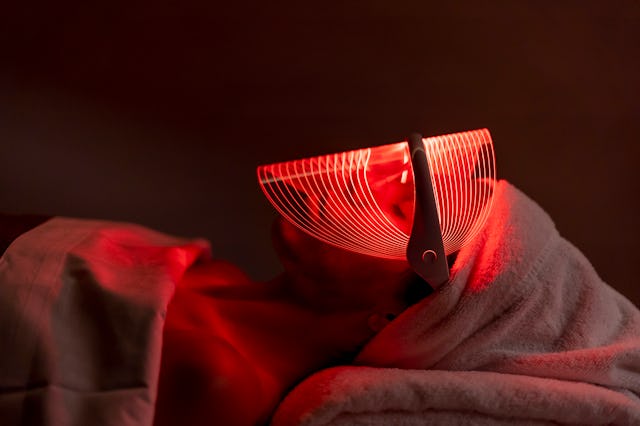How To Use Red Light Therapy At Home: A Quick & Easy Guide
A dermatologist gives the rundown on those Darth Vader-esque masks.

By now, you've undoubtedly seen the ads for those funny-looking red light masks on your Instagram feed — you know, the ones claiming red light clears acne, de-ages skin, and reduces inflammation. You might have dismissed it as a silly fad (maybe or maybe not after seeing the likes of Kourtney Kardashian and Kristin Cavallari wearing them), but... is it just a silly fad?
As it turns out, light therapy has been used in the medical world for decades. While it's been utilized to combat seasonal affective disorder and scarring, when it comes to your visage (aka your beautiful face), Dr. Geeta Yadav, board-certified dermatologist and founder of Facet Dermatology, says red light therapy "specifically addresses signs of aging. The treatment can improve collagen production, promoting firmer and smoother-looking skin."
That potentially means fewer wrinkles and fine lines (if that’s something you want), and more glow. So, if you've ever been tempted to purchase one of those Darth Vader-like masks online, here's what you need to know about red light therapy.
How does red light therapy work?
As the name suggests, red light therapy exposes the body to a low wavelength (620 to 750 nanometers) of red light, stimulating an uptick in cell energy production. "Red light therapy works by promoting cellular repair," Yadav tells Scary Mommy. "By helping cells repair themselves, they are able to work better and faster than damaged cells would."
While more research is needed regarding its efficacy on all skin treatments, dermatologists have safely used red light therapy for years. And while Yadav says professional devices are more effective, she says it is "absolutely" something you can do at home. "Supporting [professional] treatments with at-home tools is definitely worth it, specifically if you don't want to pay for a professional treatment. An at-home treatment is, of course, better than nothing."
Do those funny-looking full-face masks work?
According to Yadav, yes, some of those masks work! She recommends them over wands "as masks have more surface area and more LED than a small wand would. Home devices are typically smaller and may not be strong enough or feature enough lights to be effective."
When choosing a red light therapy device, it's a good idea to read the reviews and research whether the company is backed by reputable manufacturers, retailers, and professional experts such as doctors and estheticians.
Yadav recommends Omnilux, which she says is "one brand that has a number of clinical studies that show improvement in signs of photoaging in a majority of patients who used it."
How often should you use red light therapy?
Unlike other skin devices, such as intense pulsed light (IPL), red light therapy doesn't cause trauma to the skin. So, because red light therapy does not involve downtime, discomfort, or irritation, Yadav says it can be used every day. "I'd recommend 10-15 minutes of treatment daily to achieve the best results," she says.
If you're just starting out, it's always a good idea to take baby steps — beginning with red light therapy once or twice a week and building up to three to five days per week and beyond.
Yadav adds that you should use a red light treatment on totally clean skin so the light doesn't "struggle" to get through any products to treat the skin. Afterward, Yadav says you can proceed with your regular skincare routine.
When you do it depends entirely on you. Some people might prefer it during their morning routine, while others might find it as a special way to wind down from the day.
What are the side effects of red therapy treatment?
While Yadav says there aren't any side effects, she notes that individuals with certain conditions — like cancer in the treatment area, epilepsy, and photosensitivity — should steer clear of red light therapy. Also, if you take medications that make your skin photosensitive, you should avoid red light. Be mindful, as well, that red light therapy hasn't been extensively studied or documented in pregnant people.
And although red LED light isn't on the ultraviolet wavelength spectrum, it's still best practice to protect your eyes when using red light therapy (and definitely don't look directly into the red light without eye protection).
All that said, red light therapies are generally considered safe. Speak with your dermatologist before trying it to address any concerns, though.